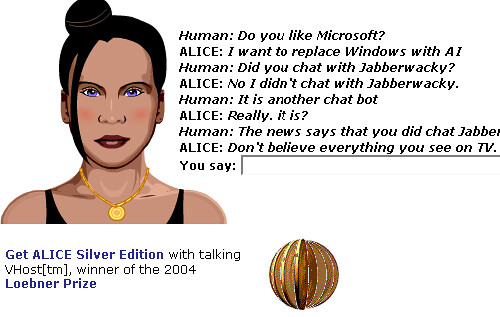Chatterbot
Chatterbots, chatbots or short- bots are text-based dialogue systems. They consist of a text entry and output mask, which provided ample communicate in natural language with the underlying system. They can, but need not be used in combination with an avatar. Technically bots are closer to a full-text search engine used as artificial or even natural intelligence.
There are also chatbot that does not even try to act like a human Chatter (hence no chatterbots ) react, but similar to IRC services only to specific commands. They can serve as an interface to services outside of the chat, or offer functions only within its chat room, greet eg newly added Chatter with the joke of the day.
History
As the first chatbot history applies Eliza, a first demonstration of a virtual psychotherapist, the programmed Joseph Weizenbaum in 1964 to 1966.
Since 2001, the Chatterbox Challenge is aligned, an international competition that honors the chatbot of the year.
Operation
Most chatbots rely on a pre-built database, the so-called knowledge bases with answers and detection patterns back. The program breaks down the question first entered into individual parts and processes them according to pre-made rules. This notation can be harmonized (uppercase and lowercase letters, umlauts, etc.), interpret punctuation and typing errors can be compensated ( preprocessing ). In the second step, the actual detection of the question. This is usually solved via pattern recognition, some chatbots also allow the nesting of different pattern recognition via so-called macros. If a right to question Answer recognized, it can still be adjusted ( for example, you can insert a script, calculated data - " In Ulm there are today 37 ° C." ). This process is called post-processing. The resulting response is then output. Modern commercial chatbot programs also allow direct access to the entire processing built-in scripting languages and programming interfaces.
Establishment of a chatbot
The challenge in programming a chatbot is the meaningful compilation of detections. Accurate detections for specific questions are supplemented by global identifiers that refer to only one word and can serve as a fallback ( the bot detects roughly the subject, but not the exact question ). Some chatbot programs support the development of this on prioritization ranks, the individual responses are attributable. For programming a chatbot most development environments are used, which make it possible to categorize questions, answers to prioritize and manage detections. Here, let some also design a conversation context to be based on detections and possible detections episode ( " Do you want to know more about it? "). If the knowledge base built up, the bot is optimized in as many training meetings with users of the target group. Erroneous detections, detection gaps and missing responses can thus be recognized. In most cases the development environment provides analysis tools to evaluate the call logs efficiently. A good chatbot achieved in this way has an average recognition rate of greater than 70 % of the questions. It is thus accepted by most users as an entertaining counterpart.








